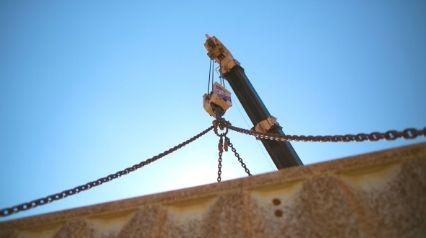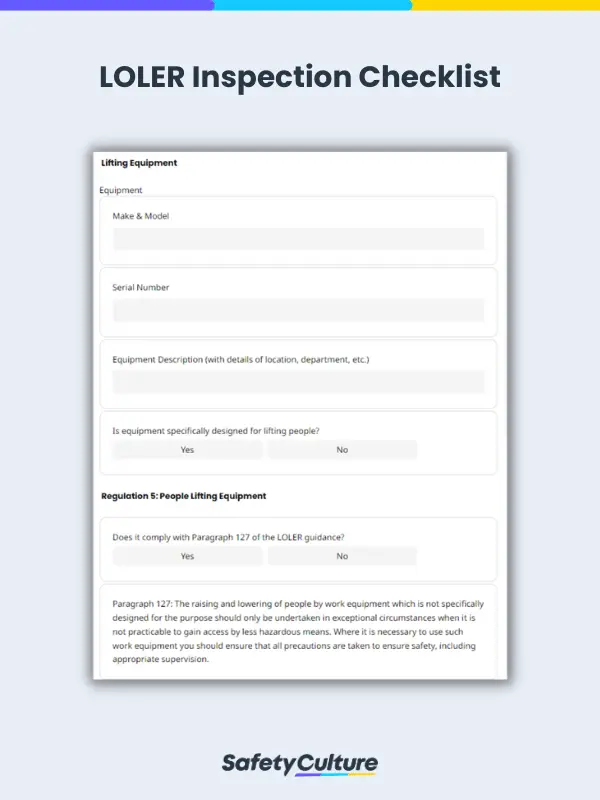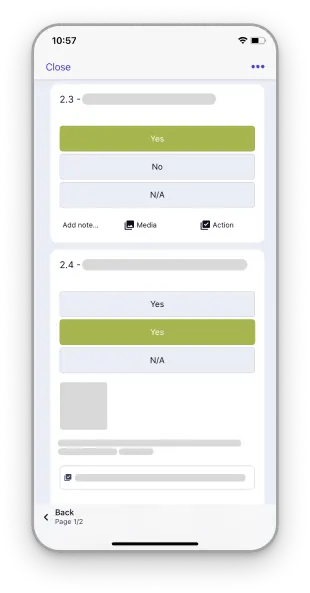What is a LOLER Inspection?
A LOLER inspection is a scheduled evaluation of UK employers’ compliance to the Lifting Operations and Lifting Equipment Regulations 1998 (LOLER). Equipment used at work for lifting or lowering loads (cranes, industrial lift trucks, hoists) and accessories for attaching loads to machinery (slings, hooks, chains) are subject to LOLER inspections, including pre-use checks, weekly, monthly, or quarterly routine maintenance, and bi-annual or annual thorough examinations.
What are LOLER Checklists?
LOLER checklists are used by site managers, area supervisors, or other competent persons to ensure the reliability and safe use of lifting equipment, demonstrate workplace safety as an ethical responsibility, and build a safety culture from the ground up. UK employers should move beyond compliance with regulations by taking advantage of LOLER inspection checklists employees can use anytime, anywhere, and on any mobile device.
LOLER Inspection FAQs
-
Is LOLER a legal requirement?
Yes. As published in the 2014 Health and Safety Executive (HSE) Approved Code of Practice, LOLER applies to every sector where work equipment is used for lifting and lowering loads. Any accessory for lifting—equipment used for attaching loads to machinery (for lifting)—is also covered by LOLER. The HSE enforces LOLER with local health and safety inspectors to ensure compliance with regulations, preventing hazards from using lifting equipment.
-
Can I perform a LOLER inspection?
Yes. LOLER inspections, specifically the annual or bi-annual thorough examinations, can be performed by a competent person who is selected by employers from their own staff members, but should not be the same person who performs routine maintenance. According to the HSE, conduct a LOLER inspection as long as you are able to detect defects or weaknesses, assess how important they are to the safety and continued use of the lifting equipment, and make objective decisions in relation to this.
-
What should I check during a LOLER inspection?
The competent person should validate the company’s compliance to the following Lifting Operations and Lifting Equipment Regulations:
- Regulation 3 – Application
- Regulation 4 – Strength and Stability
- Regulation 5 – Lifting Equipment for Lifting Persons
- Regulation 6 – Positioning and Installation
- Regulation 7 – Marking of Lifting Equipment
- Regulation 8 – Organization of Lifting Operations
- Regulation 9 – Thorough Examination and Inspection
- Regulation 10 – Reports and Defects
- Regulation 11 – Keeping of Information
How to Perform a LOLER Inspection
In 2019, two companies pleaded guilty for causing the death of a metal fabricator as they failed to properly plan and supervise their lifting operation. An HSE investigation found out that they did not recognize the risks involved nor have a safe system of work for the lift. UK employers should embrace workplace safety as an ethical responsibility, demonstrating how much they value their employees’ safety every day. To help you get started with lifting operations and lifting equipment inspections, here are 5 simple steps:
-
Use a LOLER Inspection Checklist
A LOLER inspection checklist contains exactly what you should look out for, especially for lifting equipment specifically designed for lifting people. Conducting a LOLER inspection using a checklist also helps in supporting your claims for a planned and supervised lifting operation.
-
Visually Inspect and Observe the Use of Lifting Equipment
You should specify the make, model, and serial number of the lifting equipment to be assessed. Determine if the lifting equipment is suitable for the task, safely accessible, and properly marked, positioned and installed. You may perform an overload test if overturning is a significant risk. Make sure that the lifting operation is carried out in a safe manner, especially if the load is being lifted by two or more lifting equipment simultaneously.
-
Report Defects and Unsafe Operations of Lifting Equipment
If lifting accessories used for securing the load is not compatible or if the lifting equipment operator is not adequately protected against the environment, document your observations in the LOLER inspection report and send a copy to the HSE or the local authority. The HSE stresses that if you fail to report a defect, simply because it has been remedied on the spot, your company is disguising a potentially dangerous situation.
-
Specify Corrective Actions and Follow Through
You must take action to rectify any defect, especially when it is serious and significant. Immediately take the lifting equipment out of service until the defect has been put right or replace it. A weekly LOLER check can help you maintain the reliability of your lifting equipment and extend its lifespan while keeping your employees safe.
-
Communicate Results and Keep LOLER Inspection Records
Since LOLER inspection reports can be electronically stored, sharing them with your staff can help them see areas of improvement and apply behavioral changes, especially if unsafe lifting operations have been observed. The management should review LOLER inspection records regularly, protect them from unauthorized alteration, and be able to provide copies when necessary.



